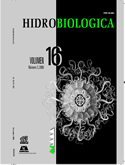Evaluation of the state of the shrimp fishery in the Gulf of Tehuantepec
Keywords:
Surplus yield, exploitation, shrimp, Gulf of Tehuantepec, evaluationAbstract
Considering the integration of the total catches of white, brown, blue and crystal shrimp in a single population, the shrimp fishery in the Gulf of Tehuantepec was evaluated between 1960 and 2002 . Schaefers model estimated a value of optimal effort (fOPT) of 151 ships and an optimal catch (COPT) of 2,342 ton (r = 0.723, p < 0.05). The models of Fox and Schaefer estimated 84 ships and 2,673 ton (r = 0.806 , p < 0.05), and 110 ships and 1,504 ton (I=39.41%), respectively. Considering the Schaefers model, two exploitation periods were observed. The first period from 1960 to 1980, during which the fishing effort was mantained relatively constant in approximately 150 and 200 ships; whereas, the second one, from 1981 to 2002, showed a fluctuation between 220 and 350 ships. Comparisons with other units of fishing effort were not made, nevertheless, the interannual variability of the capture in the first period was similar to that reported for the Gulf of Tehuantepec from 1949 to 1981, which considered the number of ships in order to develop the Schaefers model. Independently of the unit of the fishing effort utilized, both evaluations suggest that the optimal level of catch was reached and surpassed at the end of the 70s and the beginning of the 80s. This provoked the reduction of the catches during the second period. In this last period, the rate of artisanal exploitation between 1983 and 2000 was not estimated, nevertheless, we considered that it must have been greater than what was obtained by the marine fishery (0,69 annual). The combination of both fisheries has increased the level of fishing effort on the populations of shrimp in the Gulf of Tehuantepec, resulting in a critical level of explotationDownloads
Downloads
Published
How to Cite
Issue
Section
License
Los autores/as que publiquen en esta revista aceptan las siguientes condiciones:
De acuerdo con la legislación de derechos de autor, HIDROBIOLÓGICA reconoce y respeta el derecho moral de los autores, así como la titularidad del derecho patrimonial, el cual será cedido a la revista para su difusión en acceso abierto.
Publicar en la revista HIDROBIOLÓGICA tiene un costo de recuperación de $500 pesos mexicanos por página en blanco y negro (aproximadamente 29 dólares americanos) y $1000 pesos por página a color (aproximadamente 58 dólares americanos).
Todos los textos publicados por HIDROBIOLÓGICA sin excepción se distribuyen amparados bajo la licencia Creative Commons 4.0Atribución-No Comercial (CC BY-NC 4.0 Internacional), que permite a terceros utilizar lo publicado siempre que mencionen la autoría del trabajo y a la primera publicación en esta revista.
Los autores/as pueden realizar otros acuerdos contractuales independientes y adicionales para la distribución no exclusiva de la versión del artículo publicado en HIDROBIOLÓGICA (por ejemplo incluirlo en un repositorio institucional o publicarlo en un libro) siempre que indiquen claramente que el trabajo se publicó por primera vez en HIDROBIOLÓGICA.
Para todo lo anterior, el o los autor(es) deben remitir el formato de Carta-Cesión de la Propiedad de los Derechos de la primera publicación debidamente requisitado y firmado por el autor(es). Este formato se puede enviar por correo electrónico en archivo pdf al correo: enlacerebvistahidrobiológica@gmail.com; rehb@xanum.uam.mx (Carta-Cesión de Propiedad de Derechos de Autor).
Esta obra está bajo una licencia de Creative Commons Reconocimiento-No Comercial 4.0 Internacional.


